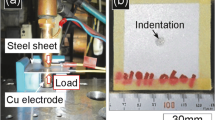Abstract
In order to be able to control the growth rate of industrial polycrystalline silicon rods well and reduce energy consumption, it is necessary to accurately locate the boundaries of the silicon rods and measure the diameter of the silicon rod during growth. In this paper, a weak edge signal detection method based on small area is proposed for the problem of weak boundary signal in the late growth stage of polycrystalline silicon rods. The method increases the gradient of the edge by projecting the boundary signal in the column direction. In addition, the method further enhances the gradient information of the weak boundary signal by improving the classical difference operator. In the experimental part, the improved difference operator increases the weak difference signal value from 304 to 686. Finally, the effectiveness of the algorithm is proved by two groups of experimental results.









Similar content being viewed by others
References
Liu, X.: Research on on-line monitoring system of silicon rod diameter in polycrystalline silicon reduction furnace. Anhui University, Hefei (2014)
Jiang, H., Cao, Z., Liu, S.: Diameter detection and deposition process of CVD polysilicon reactor. Mod. Chem. Ind. 35(3), 169–172 (2015)
Wu, H., Liu, X., Chen, X., Pang, J., Li, Z., Xiong, D.: Silicon rod diameter measurement method based on binocular vision technique. J. Atmosp. Environ. Opt. 9(5), 401–408 (2014)
Bhardwaj, S., Mittal, A.: A survey on various edge detector techniques. Proc. Technol. 4, 220–226 (2012)
Xie, S., Tu, Z.: Holistically-nested edge detection. Int. J. Comput. Vis. 125(1–3), 3–18 (2017)
Liu, Y., Cheng, M.M., Hu, X., et al.: Richer convolutional features for edge detection. IEEE Trans. Pattern Anal. Mach. Intell. 41(8), 1939–1946 (2019)
Deng R, Shen C, Liu S, et al. Learning to predict crisp boundaries. (2018). https://doi.org/10.1007/978-3-030-01231-1_35
He, K., Sun, J., Tang, X.: Single image haze removal using dark channel prior. IEEE Trans. Pattern Anal. Mach. Intell. 33(12), 2341–2353 (2011)
Sun, X., Sun, J., Zhao, L., Cao, Y.: Improved algorithm for single image haze removing using dark channel prior. J. Image Gr. 3, 381–385 (2014)
Pei S., Lee, T.: Effective image haze removal using dark channel prior and post-processing. In: 2012 IEEE International Symposium on Circuits and Systems. 2777–2780 (2012)
Singh, D., Kumar, V.: Single image haze removal using integrated dark and bright channel prior. Mod. Phys. Lett. B (2018). https://doi.org/10.1142/S0217984918500513
Narasimhan, S., Nayar, S.: Chromatic framework for vision in bad weather. In: IEEE Computer Society Conference on Computer Vision and Pattern Recognition, (CVPR2000), (2000). https://doi.org/10.1109/CVPR.2000.855874
Narasimhan, S., Nayar, K.: Vision and the Atmosphere. Int. J. Comput. Vis. 48(3), 233–254 (2002)
Fattal, R.: Single image dehazing. ACM Trans. Gr. (2008). https://doi.org/10.1145/1399504.1360671
Tan, RT.: Visibility in bad weather from a single image. In: 2008 IEEE Computer Society Conference on Computer Vision and Pattern Recognition (CVPR 2008). 2347–2354 (2008)
Yang, X., Lv, Y.: Research and implementation of grayscale image threshold segmentation based on difference operators combined with improved otsu algorithm. Instrum. Tech. Sens. 3, 104–106 (2015)
Young, N., Evans, A.N.: Median centred difference gradient operator and its application in watershed segmentation. Electron. Lett. 47(3), 178–180 (2011)
Funding
This work was supported by the National Natural Science Foundation of China under Grants No. U1830133 (NSAF).
Author information
Authors and Affiliations
Corresponding author
Ethics declarations
Conflict of interest
The authors declare that there is no conflict of interest.
Additional information
Publisher's Note
Springer Nature remains neutral with regard to jurisdictional claims in published maps and institutional affiliations.
Rights and permissions
About this article
Cite this article
Xiuyun, Z., Xiaohan, C., Ting, Z. et al. Research on detection and location of weak edge signals. SIViP 14, 1355–1360 (2020). https://doi.org/10.1007/s11760-020-01679-3
Received:
Revised:
Accepted:
Published:
Issue Date:
DOI: https://doi.org/10.1007/s11760-020-01679-3




